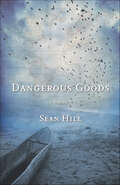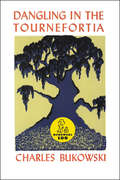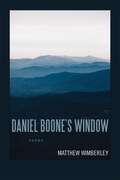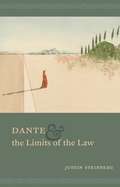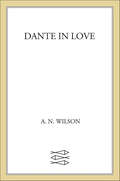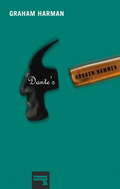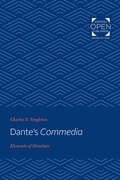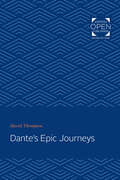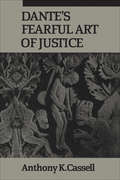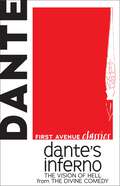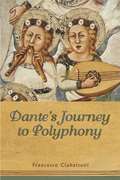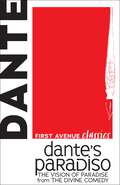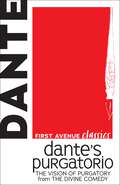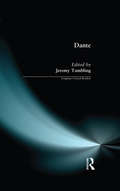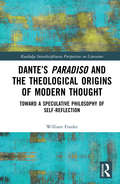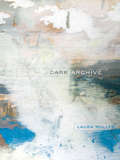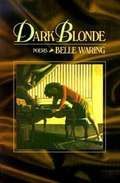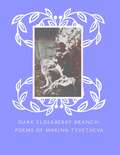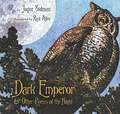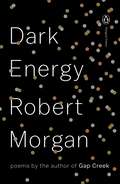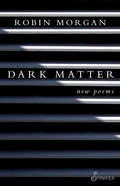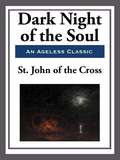- Table View
- List View
Dangerous Goods: Poems
by Sean HillWINNER OF THE MINNESOTA BOOK AWARDFrom the poet whose stunning debut was praised as &“transcendent&” by Kevin Young and &“steadily confident&” by Carl Phillips, Dangerous Goods tracks its speaker throughout North America and abroad, illuminating the ways in which home and place may inhabit one another comfortably or uncomfortably—or both, simultaneously.From the Bahamas, London, and Cairo to Bemidji, Minnesota, and Milledgeville, Georgia, Sean Hill interweaves the contemporary with the historical, and explores with urgency the relationships among travel, migration, alienation, and home. Here, playful &“postcard&” poems addressed to Nostalgia and My Third Crush Today sit alongside powerful reflections on the immigration of African Americans to Liberia during and after the era of slavery. Such range and formal innovation make Hill&’s second collection both rare and exhilarating. Part shadowbox, part migration map, part travelogue-in-verse, Dangerous Goods is poignant, elegant, and deeply moving.
Dangling in the Tournefortia
by Charles BukowskiThere is not a wasted word in Dangling in the Tournefortia, a selection of poems full of wit, struggles, perception, and simplicity. Charles Bukowski writes of women, gambling and booze while his words remain honest and pure.
Daniel Boone’s Window: Poems (Southern Messenger Poets)
by Matthew WimberleyDaniel Boone’s Window, a new book of poetry by Matthew Wimberley, meditates on the past and future of contemporary Appalachia through explorations of both mythologized and actual landscapes. In poems that confront a region indelibly shaped by environmental turmoil, economic erasure, and the weight of an outside world intent on destroying it, Daniel Boone’s Window works to reclaim and reckon with the realities and complexities of Appalachia. Wimberley’s poetry seeks to dispel monolithic narratives of the region by capturing the rugged and the beautiful, approaching place with wonderment that subverts stereotype and blame.
Dante & the Limits of the Law
by Justin SteinbergIn Dante and the Limits of the Law, Justin Steinberg offers the first comprehensive study of the legal structure essential to Dante’s Divine Comedy. Steinberg reveals how Dante imagines an afterlife dominated by sophisticated laws, hierarchical jurisdictions, and rationalized punishments and rewards. He makes the compelling case that Dante deliberately exploits this highly structured legal system to explore the phenomenon of exceptions to it, crucially introducing Dante to current debates about literature’s relation to law, exceptionality, and sovereignty. Examining how Dante probes the limits of the law in this juridical otherworld, Steinberg argues that exceptions were vital to the medieval legal order and that Dante’s otherworld represents an ideal “system of exception.” In the real world, Dante saw this system as increasingly threatened by the dual crises of church and empire: the abuses and overreaching of the popes and the absence of an effective Holy Roman Emperor. Steinberg shows that Dante’s imagination of the afterlife seeks to address this gap between the universal validity of Roman law and the lack of a sovereign power to enforce it. Exploring the institutional role of disgrace, the entwined phenomena of judicial discretion and artistic freedom, medieval ideas about privilege and immunity, and the place of judgment in the poem, this cogently argued book brings to life Dante’s sense of justice.
Dante in Love: A Biography
by A. N. WilsonFor William Butler Yeats, Dante Alighieri was "the chief imagination of Christendom." For T. S. Eliot, he was of supreme importance, both as poet and philosopher. Coleridge championed his introduction to an English readership. Tennyson based his poem "Ulysses" on lines from the Inferno. Byron chastised an "Ungrateful Florence" for exiling Dante. The DivineComedy resonates across five hundred years of our literary canon. In Dante in Love, A. N. Wilson presents a glittering study of an artist and his world, arguing that without an understanding of medieval Florence, it is impossible to grasp the meaning of Dante's great poem. He explains how the Italian states were at that time locked into violent feuds, mirrored in the ferocious competition between the Holy Roman Empire and the Papacy. He shows how Dante's preoccupations with classical mythology, numerology, and the great Christian philosophers inform every line of the Comedy. Dante in Love also explores the enigma of the man who never wrote about the mother of his children, yet immortalized the mysterious Beatrice whom he barely knew. With a biographer's eye for detail and a novelist's comprehension of the creative process, A. N. Wilson paints a masterful portrait of Dante Alighieri and unlocks one of the seminal works of literature for a new generation of readers.
Dante's Broken Hammer
by Graham HarmanIn this book the founder of object-oriented philosophy transforms one of the classic poets of the Western canon, Dante Alighieri, into an edgy stimulus for contemporary continental thought. It is well known that Dante's poetic works interpret love as the moving force of the universe: as embodied in his muse Beatrice from La Vita Nuova onward, as well as the much holier persons inhabiting Paradiso. Likewise, if love is the ultimate form of sincerity, it is easy to interpret the Inferno as a brilliant counterpoint of anti-sincerity, governed by fraud and blasphemy along with the innocuous form of fraud known as humor (strangely absent from all parts of Dante's cosmos other than hell). In turn, the middle ground of Purgatorio is where Harman locates Dante's clearest theory of sincerity. Yet this is only the beginning. For while Dante provides a suitable background for the metaphysics of commitment found in such later thinkers as Pascal, Kierkegaard, Sartre, and Badiou, he also provides even more important resources for overcoming two centuries of philosophy shaped by Immanuel Kant.From the Trade Paperback edition.
Dante's Commedia: Elements of Structure
by Charles S. SingletonOriginally published in 1977. This book contains four essays by Professor Charles Singleton: "Allegory," "Symbolism," "The Pattern at the Center," and "The Substance of Things Seen." These four essays treat four dimensions of meaning essential to understanding the substance and special texture of the poetry of the Divine Comedy. One might speak of "facets" or "aspects" of meaning if such terms did not suggest surface reflections dependent on the way a work (as a jewel) is turned for inspection. But for Singleton, each dimension has a depth that reaches to the core and substance of Dante's poetry, so they are, in Singleton's view, elements of its structure.
Dante's Divine Comedy: A Biography
by Joseph LuzziThe life and times of Dante&’s soaring poetic allegory of the soul&’s redemptive journey toward GodWritten during his exile from Florence in the early 1300s, Dante Alighieri&’s Divine Comedy describes the poet&’s travels through hell, purgatory, and paradise, exploring the state of the human soul after death. His poema sacro, sacred poem, profoundly influenced Renaissance writers and artists such as Giovanni Boccaccio and Sandro Botticelli and was venerated by modern critics including Erich Auerbach and Harold Bloom. Dante&’s &“Divine Comedy&” narrates the remarkable reception of Dante&’s masterpiece, one of the most consequential religious books ever written.Tracing the many afterlives of Dante&’s epic poem, Joseph Luzzi shows how it left its mark on the work of such legendary authors as John Milton, Mary Shelley, and James Joyce while serving as a source of inspiration for writers like Primo Levi and Antonio Gramsci as they faced the most extreme forms of political oppression. He charts how the dialogue between religious and secular ideas in The Divine Comedy has shaped issues ranging from changing conceptions of women&’s identity and debates about censorship to the role of canonical literature in popular culture.An intimate portrait of a work that has challenged and inspired generations of readers, Dante&’s &“Divine Comedy&” reveals how Dante&’s strikingly original and controversial vision of the afterlife can help us define our spiritual beliefs, better understand ourselves, and navigate the complexities of modern life.
Dante's Epic Journeys
by David ThompsonOriginally published in 1974. This book on comparative literature represents the first extended attempt to relate Dante's major allegorical mode to classical and medieval interpretations of epic poetry rather than to patristic biblical exegesis. Dante's Epic Journeys is also the first comprehensive explanation of Dante's enigmatic Ulysses. Thompson strives to shed new light not only on Dante's allegory—and thus upon the whole troubled question of exactly what an allegory was thought to be—but also on the intricate relationship between poet and poem and between Dante's spiritual journeys and his written representation of those itineraries.
Dante's Fearful Art of Justice
by Anthony CassellDante's Fearful Art of Justice deals primarily with the symbolic significance of 'the state of souls after death' in various episodes of the Inferno, the first canticle of Dante's Divina Commedia. The fruitlessness of the Auerbach-Singleton approach to the poem is demonstrated by Professor Cassell's investigations, which are based on the belief that Dante used both the theological system of fourfold allegory and the preconfiguration-fulfilment pattern of history found in the Old and New Testaments. The author first deals with the history of contrapassum, 'just retribution,' as it appeared in philosophy and theology, and describes Dante's use of historical and artistic figuration, both classical and Christian. It is central to Cassell's aim to show how Dante believed that his portrayal of the damned revealed the justice of God. Critics have believed that the relation of sin to the suffering of the shades in Hell was tenuous or even arbitrary in many cases. Cassell shows, through a close examination of Dante's assimilation of the Classics (and their medieval interpretations), or patristics, and of traditional iconography, that there is an intimate metaphorical and artistic aptness in the poet's representation. Cassell relies at some points on art history, and thirty-four illustrations of frescoes, statuary, and illuminations from paleo-Christian times to the fourteenth century are therefore included.This volume will be of particular interest to medieval specialists, historians of the Renaissance and Reformation periods, and those concerned with European literature.
Dante's Inferno: The Vision of Hell from The Divine Comedy (First Avenue Classics ™ #Vol. 1)
by Dante AlighieriInferno is the first part of Italian poet Dante Alighieri's epic poem Divine Comedy. The allegory describes Dante's journey through the depths of Hell. He is led by the Roman poet Virgil down into the nine circles of Hell, each of which holds and punishes progressively worse sinners. From the First Circle, where unbaptized souls live in peaceful limbo, down to the Ninth Circle, where Satan is trapped in ice, Dante sees firsthand the consequence of unrepentantly sinning against God. Dante published his narrative poem between 1308 and 1321. This version is taken from an 1892 English edition, featuring British author Rev. H. F. Cary's blank verse translation and woodcut illustrations by French artist Gustave Doré.
Dante's Journey to Polyphony
by Francesco CiabattoniIn Dante's Journey to Polyphony, Francesco Ciabattoni's erudite analysis sheds light on Dante's use of music in the Divine Comedy. Following the work's musical evolution, Ciabattoni moves from the cacophony of Inferno through the monophony of Purgatory, to the polyphony of Paradise and argues that Dante's use of sacred songs constitutes a thoroughly planned system. Particular types of music accompany the pilgrim's itinerary and reflect medieval theories regarding sound and the sacred. Combining musicological and philological scholarship, this book analyzes Dante's use of music in conjunction with the form and content of his verse, resulting in a cross-discipline analysis also touching on Italian Studies, Medieval Studies, and Cultural History. After moving from infernal din to heavenly harmony, Ciabattoni's final section addresses the music of the spheres, a theory that enjoyed great diffusion among the early middle ages, inspiring poets and philosophers for centuries.
Dante's Paradiso: The Vision of Paradise from The Divine Comedy (First Avenue Classics ™)
by Dante AlighieriParadiso is the third and final part of Italian poet Dante Alighieri's epic poem Divine Comedy and describes Dante's journey through heaven. He is now led by Beatrice, who joined him at the end of Purgatorio. Beatrice takes Dante into the nine celestial spheres of Heaven. From the First Sphere, where they find those who were good but did not keep their vows, to the Ninth Sphere and the Empyrean, the home of the angels and God, Dante experiences the blessings given to those who live a life faithful to God. Dante wrote his narrative poem between 1308 and 1321. This version is taken from a 1901 English edition, featuring British author Rev. H. F. Cary's blank verse translation and woodcut illustrations by French artist Gustave Doré.
Dante's Purgatorio: The Vision of Purgatory from The Divine Comedy (First Avenue Classics ™)
by Dante AlighieriPurgatorio is the second part of Italian poet Dante Alighieri's epic poem Divine Comedy and describes Dante's climb up the Mount of Purgatory. As in the Inferno, the Roman poet Virgil is guiding Dante on a journey; this time they visit the seven terraces of Purgatory, where sinners are cleansing themselves in preparation for entering Paradise. Each of the terraces represents one of the seven deadly sins, ranging from pride to lust. Through this allegory, Dante conveys that repentant souls can be redeemed. Dante wrote his narrative poem between 1308 and 1321. This version is taken from a 1901 English edition, featuring British author Rev. H. F. Cary's blank verse translation and woodcut illustrations by French artist Gustave Doré.
Dante: States Of Affect (Longman Critical Readers #18)
by Jeremy TamblingDante's work has fascinated readers for seven hundred years and has provided key reference points for writing as diverse as that of Chaucer, the Renaissance poets, the English Romantics, Tennyson and the Pre-Raphaelites, American writers from Melville through to Eliot and Pound, Anglo-Irish Modernists from Joyce to Beckett, and contemporary poets such as Heaney and Walcott.In this volume, Jeremy Tambling has selected ten recent essays from the mass of Dante studies, and put the Divine Comedy - Dante's record of a journey to Hell, Purgatory and Paradise - into context for the modern reader. Topics such as Dante's allegory, his relationship to classical and modern poetry, his treatment of love and of sexuality, his attitudes to Florence and to his contemporary Italy, are explored and clarified through a selection of work by some of the best scholars in the field. An introduction and notes help the reader to situate the criticism, and to relate it to contemporary literary theory. In this anthology, Dante's relevance to both English and Italian literature is highlighted, and the significance of Dante for poetry in English is illuminated for the modern reader.This book provides students of English literature and Italian literature with the most comprehensive collection of important critical studies of Dante to date.
Dante’s Paradiso and the Theological Origins of Modern Thought: Toward a Speculative Philosophy of Self-Reflection (Routledge Interdisciplinary Perspectives on Literature)
by William FrankeSelf-reflection, as the hallmark of the modern age, originates more profoundly with Dante than with Descartes. This book rewrites modern intellectual history, taking Dante’s lyrical language in Paradiso as enacting a Trinitarian self-reflexivity that gives a theological spin to the birth of the modern subject already with the Troubadours. The ever more intense self-reflexivity that has led to our contemporary secular world and its technological apocalypse can lead also to the poetic vision of other worlds such as those experienced by Dante. Facing the same nominalist crisis as Duns Scotus, his exact contemporary and the precursor of scientific method, Dante’s thought and work indicate an alternative modernity along the path not taken. This other way shows up in Nicholas of Cusa’s conjectural science and in Giambattista Vico’s new science of imagination as alternatives to the exclusive reign of positive empirical science. In continuity with Dante’s vision, they contribute to a reappropriation of self-reflection for the humanities.
Dao De Jing
by LaoziA landmark translation of the timeless classic of Daoist wisdom, rendered in gorgeous poetry that illuminates its enduring teachings. This bold new translation by two brilliant poets offers a contemporary perspective on a timeless masterpiece of Daoist scripture, introducing Dao De Jing to a new audience while retaining the majesty of the Chinese original. Composed of eighty-one short poems written by the sage Laozi in 400 BC, Dao De Jing is one of the pillars of Chinese thought. Acclaimed poet Li-Young Lee and poet and scholar Yun Wang illuminate Dao De Jing as a unified work of art. This revelatory and faithful translation—presented alongside the original Chinese text—reveals its enduring teachings in their profound simplicity, subtlety, and balance.
Dark Archive
by Laura MullenDark archive: The purpose of a dark archive is to function as a repository for information that can be used as a failsafe during disaster recovery. Laura Mullen's fourth collection is a sequence of beautifully interrelated poems that explores how to accurately represent the reality of change and loss. Mullen pinpoints what is at stake: the possibility of communication and connection--and the hope of intimacy. Invoking Wordsworth's "I wandered lonely as a cloud," she pushes experiments in consciousness against their boundaries in an array of poetic forms. Poetic tropes are measured against natural phenomena as Mullen examines what "witness" might mean in the context of the aftermath of Hurricane Katrina, the failures of capitalism to effect social justice, the murder of James Byrd in Texas, the personal loss of a mother figure, and a disintegrating love affair.
Dark Blonde: Poems
by Belle WaringWaring has worked as a neo-natal intensive care nurse and as Writer-in-Residence at Children's National Medical Center in Washington D.C. Her first collection of poetry, Refuge, won the Associated Writing Program's Award for Poetry in 1989, the Washington Prize in 1991, and was cited by Publishers Weekly as one of the best books of 1990. Her second collection Dark Blonde received the San Francisco Poetry Center Poetry Prize and the Larry Levis Reading Prize in 1997. It was published by Louisville's Sarabande Books. "Drawing from her work as a neonatal nurse and from some more common experiences (e.g. nervous breakdowns, incest and poverty), Waring exhibits the street-smart ear and unflinching eye that made her first collection, Refuge, one of PW's Best Books of 1990. The images and headlong rhythms of these new poems exert a wide-ranging, often irresistible pull."-Publishers Weekly (starred review) "Waring creates a voice that we feel we can trust to lead us to the center of an experience, maybe because her language never feels artificial but seems to grow naturally out of the situation it presents. The remarkable range of subjects and characters in Waring's poems leads to an equally remarkable variety of tones and vocabularies."-Word House, Baltimore's Literary Calendar "When Belle Waring reads her poetry, the jazz-inflected words escape her mouth like a Lester Young solo: quietly, melodically, forcefully. . . . she provides weight to each short line, drawing out her words like sensuous kisses. Her work is also punctuated with politics and humor."-D.C. City Paper "Poetry, Robert Frost once said, is a way of taking life by the throat. It is in this tradition that poet and nurse Belle Waring approaches her craft-seizing difficult subjects and holding them in time. . . . "-Salon Waring has written a collection that doesn't renege on us the promise of her first book and indeed has honed her craft to include a wider range of tonal shifts and allow for a finer lyricism while not losing the syncopated snap and humor of her earlier voice."-Indiana Review
Dark Elderberry Branch: Poems of Marina Tsvetaeva
by Jean Valentine Ilya Kaminsky Marina Tsvetaeva"A poet of genius."--Vladimir Nabokov. Via what Ilya Kaminsky and Jean Valentine call "readings"-not translations-of fragments of Marina Tsvetaeva's poems and prose, Tsvetaeva's lyrical genius is made accessible and poignant to a new generation of readers. By juxtaposing fragments of her poems with short pieces of prose, we begin to know her as poet, friend, enemy, woman, lover, and revolutionary. From "Poems for Moscow (2)": 'From my hands-take this city not made by hands,my strange, my beautiful brother. ' 'Take it, church by church-all forty times forty churches,and flying up over them, the small pigeons;' 'And Spassky Gates-in their flower-where the Orthodox take off their hats;' 'And the Chapel of Stars-refuge chapel-where the floor is-polished by tears;' 'Take the circle of the five cathedrals,my soul, my holy friend. 'Marina Tsvetaeva was born in Moscow in 1892 and died in 1941. Her poetry stands among the greatest works of twentieth century Russian writers. Ilya Kaminsky is the author of 'Dancing in Odessa' (Tupelo Press, 2004) which won the Whiting Writers' Award, the American Academy of Arts and Letters' Metcalf Award, the Dorset Prize, and the Ruth Lilly Poetry Fellowship awarded annually by 'Poetry 'magazine. Jean Valentine won the Yale Younger Poets award for 'Dream Barker' in 1965. Her eleventh book of poetry is 'Break the Glass', from Copper Canyon Press. 'Door in the Mountain: New and Collected Poems 1965-2003' was the winner of the 2004 National Book Award for Poetry.
Dark Emperor and Other Poems of the Night
by Joyce SidmanCome feel the cool and shadowed breeze, come smell your way among the trees, come touch rough bark and leathered leaves: Welcome to the night. Welcome to the night, where mice stir and furry moths flutter. Where snails spiral into shells as orb spiders circle in silk. Where the roots of oak trees recover and repair from their time in the light. Where the porcupette eats delicacies-raspberry leaves!-and coos and sings. Come out to the cool, night wood, and buzz and hoot and howl-but do beware of the great horned owl-for it's wild and it's windy way out in the woods!<P><P> Newbery Medal Honor book
Dark Energy
by Robert MorganA new collection from the awardwinning poet and author of the bestselling novel Gap CreekIn the words of Poetry magazine, Robert Morgan's poems "shine with beauty that transcends locale." The work in his newest collection, rooted in his native Blue Ridge Mountains, explores the mysteries and tensions of family and childhood, the splendors and hidden dramas of the natural world, and the agriculture that supports all culture. Morgan's voice is vigorous and exact, opening doors for the reader, finding unexpected images and connections. The poems reach beyond surfaces, to the strange forces inside atoms, our genes, our heritage, and outward to the farthest movements of galaxies, the dark energy we cannot explain but recognize in our bones and blood, in our deepest memories and imagination.
Dark Fields of the Republic: Poems 1991-1995
by Adrienne Rich"When does a life bend towards freed? grasp its direction" asks Adrienne Rich in Dark Fields of the Republic, her major new work. Her explorations go to the heart of democracy and love, and the historical and present endangerment of both. A theater of voices of men and women, the dead and the living, over time and across continents, the poems of Dark Fields of the Republic take conversations, imaginary and real, actions taken for better or worse, out of histories and songs to extend the poet's reach of witness and power of connection--and then invites the reader to participate.
Dark Matter: New Poems
by Robin MorganI‘ve had me up my sleeve I‘ve pulled me from my hat I've planted myself in the audience as the patsy I dare to decipher my tricks— safe I can never see through me. The Magician and The Magician's Assistant-- I‘ve been both for so long . . . from here on in, all that's left is the magic.In this major new book of poems, her seventh, Robin Morgan rewards us with the award-winning mastery we've come to expect from her poetry. Her gaze is unflinching, her craft sharp, her mature voice rich with wry wit, survived pain, and her signature chord: an indomitable celebration of life. This powerful collection contains the now-famous poems Morgan reads in her TED Talk--viewed online more than a million times and translated into 24 languages. Dark Matter is an unforgettable book.
Dark Night of the Soul
by St. John of the CrossWhile imprisoned in a tiny prison cell for his attempts to reform the Church, sixteenth-century Spanish mystic John of the Cross composed many of his now classic poems of the soul's longing for God. Written on a scroll smuggled to him by one of his guards, his songs are the ultimate expression of the spiritual seeker's journey from estranged despair to blissful union with the divine After escaping his captors, John fell into a state of profound ecstasy and wrote Dark Night of the Soul. Later, he added an important commentary to his poem to guide other searching souls along the arduous path to communion with God. Here, for the first time, a scholar unaffiliated with the Catholic Church has translated this timeless work. Mirabai Starr, who has studied Buddhism, Hinduism, and Judaism, lends the seeker's sensibility to John's powerful text and brings this classic work to the twenty-first century in a brilliant and beautiful rendering
